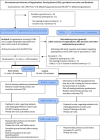Implementation of a Stepwise, Multidisciplinary Intervention for Pain and Challenging Behaviour in Dementia (STA OP!): A Process Evaluation
- PMID: 30220897
- PMCID: PMC6137609
- DOI: 10.5334/ijic.3973
Implementation of a Stepwise, Multidisciplinary Intervention for Pain and Challenging Behaviour in Dementia (STA OP!): A Process Evaluation
Abstract
Background: A stepwise, multidisciplinary and multicomponent intervention (called STA OP!) was implemented in Dutch nursing home units, which included a comprehensive multidisciplinary team training. A cluster-randomised controlled trial showed that the intervention reduced symptoms of pain and challenging behaviour.
Objectives: To describe the experiences around the implementation of the intervention; to examine the extent to which the STA OP! intervention was delivered and implemented as intended (at the level of the team, and the individual resident/professional); and to understand factors influencing the implementation process.
Methods: A process evaluation was performed using a mixed-methods design encompassing several data sources. Quantitative data (i.e. from the written evaluations by healthcare professionals, management, and the research database) were analysed using descriptive statistics. Qualitative data (i.e. semi-structured interviews, notes, completed intervention forms, and written evaluations) were analysed according to the principles of thematic analysis. The implementation process and the influencing factors were categorised according to the i) organisational level, ii) the team level, and iii) the level of the individual resident/professional.
Results: In total, 39.2% of the residents with pain and/or challenging behaviour were treated following the stepwise approach of the STA OP! intervention. The training manual and forms used were found to be relevant and feasible. Factors inhibiting the implementation process at the i) organisational level concerned instability of the organisation and the team (e.g. involvement in multiple projects/new innovations, staff turnover/absence of essential disciplines, and/or high workload). At the team level (ii), we found that presence of a person with a motivational leadership style facilitated the implementation. Also, interdisciplinary cooperation through the design/setting of the multidisciplinary training, securing the intervention by use of clear agreements, and written reporting or transfers facilitated implementation. At the individual level (iii), perceived value of the stepwise working method, and enhanced awareness facilitated the implementation.
Conclusion: Although the intervention was not implemented as planned, the intervention empowered healthcare professionals and increased their awareness of the signals of pain and challenging behaviour. Future implementation of the intervention should start on units with a motivational leader, and specific features of the organisation and the team should be considered to facilitate implementation, e.g. stability, support, and shared focus to change.
Keywords: Health Plan Implementation; behaviour; dementia; intervention; nursing homes; pain; process evaluation; program evaluation.
Figures
Similar articles
-
The implementation of the serial trial intervention for pain and challenging behaviour in advanced dementia patients (STA OP!): a clustered randomized controlled trial.BMC Geriatr. 2011 Mar 24;11:12. doi: 10.1186/1471-2318-11-12. BMC Geriatr. 2011. PMID: 21435251 Free PMC article. Clinical Trial.
-
[Effects of a stepwise approach to behavioural problems in dementia: a cluster randomised controlled trial].Ned Tijdschr Geneeskd. 2016;160:D409. Ned Tijdschr Geneeskd. 2016. PMID: 27299496 Clinical Trial. Dutch.
-
Effects on pain of a stepwise multidisciplinary intervention (STA OP!) that targets pain and behavior in advanced dementia: A cluster randomized controlled trial.Palliat Med. 2018 Mar;32(3):682-692. doi: 10.1177/0269216316689237. Epub 2017 Feb 1. Palliat Med. 2018. PMID: 28142397 Clinical Trial.
-
Effects of a Stepwise Multidisciplinary Intervention for Challenging Behavior in Advanced Dementia: A Cluster Randomized Controlled Trial.J Am Geriatr Soc. 2016 Feb;64(2):261-9. doi: 10.1111/jgs.13868. Epub 2016 Jan 25. J Am Geriatr Soc. 2016. PMID: 26804064 Clinical Trial.
-
Staff experiences with implementing a case conferencing care model in nursing homes: a focus group study.BMC Health Serv Res. 2019 Mar 27;19(1):191. doi: 10.1186/s12913-019-4034-0. BMC Health Serv Res. 2019. PMID: 30917815 Free PMC article. Clinical Trial.
Cited by
-
Models for delivery and co-ordination of primary or secondary health care (or both) to older adults living in aged care facilities.Cochrane Database Syst Rev. 2024 Mar 1;3(3):CD013880. doi: 10.1002/14651858.CD013880.pub2. Cochrane Database Syst Rev. 2024. PMID: 38426600 Free PMC article.
-
Implementing a Personalized Integrated Stepped-Care Method (STIP-Method) to Prevent and Treat Neuropsychiatric Symptoms in Persons With Dementia in Nursing Homes: Protocol for a Mixed Methods Study.JMIR Res Protoc. 2022 Jun 22;11(6):e34550. doi: 10.2196/34550. JMIR Res Protoc. 2022. PMID: 35731558 Free PMC article.
-
'Don't let the trial kill the intervention': how can researchers and care home teams implement complex intervention trials in care homes?Age Ageing. 2022 Mar 1;51(3):afac068. doi: 10.1093/ageing/afac068. Age Ageing. 2022. PMID: 35349628 Free PMC article. No abstract available.
-
A realist evaluation of a multifactorial falls prevention programme in care homes.Age Ageing. 2022 Dec 5;51(12):afac263. doi: 10.1093/ageing/afac263. Age Ageing. 2022. PMID: 36469088 Free PMC article.
-
Tailored interventions for inappropriate psychotropic drug use in nursing home residents with dementia: participatory action research in a special case of a stepped-wedge cluster randomized controlled trial.BMC Geriatr. 2025 Aug 2;25(1):581. doi: 10.1186/s12877-025-06206-y. BMC Geriatr. 2025. PMID: 40753407 Free PMC article. Clinical Trial.
References
-
- World Health Organization (WHO). International statistical classification of diseases and related health problems: World Health Organization; 2004.
-
- Rajkumar, AP, Ballard, C, Fossey, J, Orrell, M, Moniz-Cook, E and Woods, RT, et al. Epidemiology of Pain in People With Dementia Living in Care Homes: Longitudinal Course, Prevalence, and Treatment Implications. J Am Med Dir Assoc., 2017; 18(5): 453.e1–453.e6. - PubMed
-
- Tosato, M, Lukas, A, van der Roest, HG, Danese, P, Antocicco, M, Finne-Soveri, H, et al. Association of pain with behavioral and psychiatric symptoms among nursing home residents with cognitive impairment: results from the SHELTER study. Pain, 2012; 153(2): 305–10. DOI: 10.1016/j.pain.2011.10.007 - DOI - PubMed
LinkOut - more resources
Full Text Sources
Other Literature Sources
Miscellaneous


